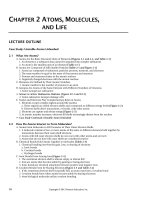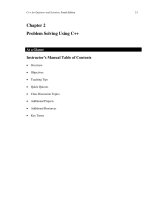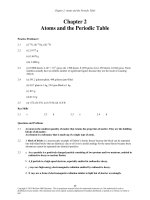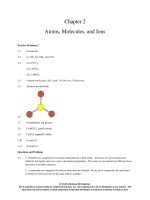Test band and solution of chemistry for changing times 13e by hill (2)
Bạn đang xem bản rút gọn của tài liệu. Xem và tải ngay bản đầy đủ của tài liệu tại đây (9.74 KB, 2 trang )
Chapter 2: Atoms
Overview
Chapter 2 begins with the Greek concept of matter and moves chronologically forward
through the development of the atomistic model of matter.
Lecture Outline
2.1
2.2
2.3
2.4
2.5
Atoms: Ideas from the Ancient Greeks
The Greek philosophers had two main ideas regarding matter:
(a) The atomistic view (Leucippus and Democritus)
(b) The continuous view (Aristotle)
Scientific Laws: Conservation of Mass and Definite Proportions
Lavoisier was the first great experimentalist. More than anything, he
introduced experimental chemistry to Western civilization. Through his
experiments, he formulated the Law of Conservation of Mass, which states
that matter is neither created nor destroyed during a chemical reaction.
John Dalton and the Atomic Theory of Matter
John Dalton summarized the work of Lavoisier and Proust to form the
famous Atomic theory.
Mendeleev and the Periodic Table
John Dalton established relative atomic masses using hydrogen as a base.
Mendeleev arranged a table of elements according to increasing atomic
weights placing elements with similar properties in the same column. This
was the beginning of the modern periodic table.
Atoms and Molecules: Real and Relevant
Demonstrations
1. Electrolysis of water.
2. Fill three flasks with zinc (gray powder), sulfur (yellow powder), and zinc sulfide
(white powder), and show to the class to illustrate how the properties of a compound
differ from those of the component elements. (Or use mercury [silver liquid], oxygen
[colorless gas], and mercuric oxide [red powder].)
3. Use samples of metals and nonmetals to demonstrate the difference in their
properties. (Aluminum foil, copper wire, nickel coin, zinc strip; capped bottle
of liquid bromine, balloon filled with hydrogen, bottles of carbon, sulfur, etc.)
4. Using the largest nuts and bolts you can find, start with unequal numbers of
nuts and bolts (e.g., 5 and 7). Connect the pairs of nuts and bolts, with some
remaining unpaired, to illustrate the Law of Definite Proportions.
Copyright © 2013 Pearson Education, Inc.
5. Heat a sample of HgO in a large test tube with a burner. Mercury droplets
form on the inside of the tube. Test for oxygen with a glowing splint, which
bursts into flame when inserted into the test tube.
Copyright © 2013 Pearson Education, Inc.









